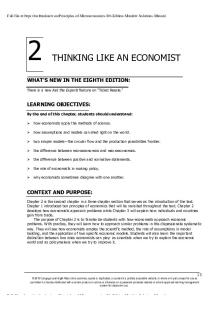Chapter 2 Summary - Microeconomics: Principles, Problems, and Policies PDF

| Title | Chapter 2 Summary - Microeconomics: Principles, Problems, and Policies |
|---|---|
| Author | DANIEL DESKINS |
| Course | Principles Of Microeconomics |
| Institution | Old Dominion University |
| Pages | 1 |
| File Size | 52.3 KB |
| File Type | |
| Total Downloads | 45 |
| Total Views | 140 |
Summary
Brief information from chapter 2 of "Microeconomics" by McConnell, Brue, and Flynn. ...
Description
Daniel Deskins February 2, 2018 ECON 202 Chapter 2 Summary Economic systems are everywhere in the world. They are sets of institutionalized arrangements with a coordinating mechanism that every country adopts. The differences between different systems can be asked by these questions: Who owns the factors of production? What method is used to motivate, coordinate, and direct economic activity? Systems can also differ if they have either a degree of decentralized use of markets and prices in decision-making or have that of centralized government control. The command system is the economic system that is run solely by the government. It is also called socialism and communism. In this system, the government owns most, if not all of the resources and use a central planning board to make economic decisions. There are, however, problems with this system. The first is the coordinating problem, which is the attempt to set output targets to all goods. The second problem is the incentive, in which there are no adjustments for shortages or surpluses. The free-market system, or capitalism, is when the private markets run the economy with some government interference. Unlike the command system, this system is found in much of the world, and is known for private ownership of resources and gives everyone more economic freedom. The government may only interfere if it is needed to allocate for market failures. To find out which system is being used, we ask ourselves the Five Fundamental Questions: What goods and services will be produced? How will the goods and services be produced? Who will get the goods and services? How will the system accommodate change? How will the system promote progress? The Invisible Hand exists regardless of which economic system is being used. Identified in 1776 by Alex Smith in his book, Wealth of Nations, it is the tendency of competitors to accidently promote the interests of society as though guided by an “invisible hand.” The three virtues of the market system under this are efficiency, incentives, and freedom. The Circular Flow Model is the model that shows how the economy works without interference from the government. It shows the roles of the households, product markets, firms, and the resource markets, and how these groups work together in the free-market system....
Similar Free PDFs

Accounting Principles & Policies
- 4 Pages

Principles of microeconomics HW1
- 10 Pages

Microeconomics Chapter 2 test bank
- 47 Pages
Popular Institutions
- Tinajero National High School - Annex
- Politeknik Caltex Riau
- Yokohama City University
- SGT University
- University of Al-Qadisiyah
- Divine Word College of Vigan
- Techniek College Rotterdam
- Universidade de Santiago
- Universiti Teknologi MARA Cawangan Johor Kampus Pasir Gudang
- Poltekkes Kemenkes Yogyakarta
- Baguio City National High School
- Colegio san marcos
- preparatoria uno
- Centro de Bachillerato Tecnológico Industrial y de Servicios No. 107
- Dalian Maritime University
- Quang Trung Secondary School
- Colegio Tecnológico en Informática
- Corporación Regional de Educación Superior
- Grupo CEDVA
- Dar Al Uloom University
- Centro de Estudios Preuniversitarios de la Universidad Nacional de Ingeniería
- 上智大学
- Aakash International School, Nuna Majara
- San Felipe Neri Catholic School
- Kang Chiao International School - New Taipei City
- Misamis Occidental National High School
- Institución Educativa Escuela Normal Juan Ladrilleros
- Kolehiyo ng Pantukan
- Batanes State College
- Instituto Continental
- Sekolah Menengah Kejuruan Kesehatan Kaltara (Tarakan)
- Colegio de La Inmaculada Concepcion - Cebu












